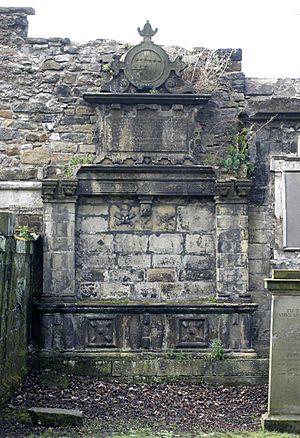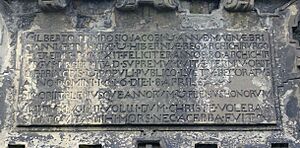Gilbert Primrose (surgeon) facts for kids
Gilbert Primrose (born around 1535 – died 18 April 1616) was a skilled Scottish surgeon. He became the main surgeon to King James VI of Scotland. When King James also became King of England in 1603 (an event called the Union of the Crowns), Gilbert Primrose moved with the King's court to London. There, he became the King's chief surgeon, known as the Serjeant-Surgeon. He was also chosen three times to lead the group of surgeons and barbers in Edinburgh, called the Incorporation of Surgeons and Barbers.
Contents
Early Life and Training
Gilbert Primrose was born around 1540 in a place called Culross, in Fife, Scotland. His parents were Duncan Primrose and Helen Smyth. In 1558, when he was about 18, he started training to be a surgeon. He became an apprentice to Robert Henrysoun, who was one of the first members of the Incorporation of Surgeons and Barbers of Edinburgh.
Gilbert Primrose's Career
Gilbert Primrose was a very busy surgeon. In 1558, Scotland was worried about attacks from "the old enemies of England." The craft guilds in Edinburgh, including the surgeons, had to list men who could help if there was an attack. Gilbert Primrose was on that list.
He often helped people with injuries. For example, in 1575, he was sent to help a messenger named Ninian Cockburn who had a broken leg.
Gilbert Primrose became the main surgeon for King James VI. In 1592, he treated the Earl of Angus, who was hurt after falling from his horse. In 1594, he was part of the team that helped Anne of Denmark, the Queen, when she gave birth to Prince Henry at Stirling Castle.
He was good friends with Dr. Peter Lowe, who helped start the Faculty of Physicians and Surgeons in Glasgow. Peter Lowe even dedicated the first edition of his surgery textbook to Gilbert Primrose.
Leading the Surgeons' Group
Gilbert Primrose was chosen to be the leader, or Deacon, of the Incorporation of Surgeons and Barbers three times. This was a big honor. When he was Deacon in 1581, the surgeons' group became the most important of the 14 craft groups in Edinburgh.
When he was elected Deacon for the third time in 1602, he made sure that all members followed the rules of their group. He also helped create new rules to keep high standards for surgeons. Members had to pay fees and subscriptions. The group grew stronger under his leadership.
Moving to London
In 1603, King James VI of Scotland also became King James I of England. This event is known as the Union of the Crowns. Gilbert Primrose, as the King's chief surgeon, moved with the royal family to London. He continued to be the main surgeon for King James and Queen Anne in England.
First Name on the Surgeons' Roll
The Royal College of Surgeons of Edinburgh keeps a list of all its members. This list started in 1581, and Gilbert Primrose was the leader (Deacon) at that time. Because of this, his name is the very first on the official list of Fellows, and it has continued without a break ever since.
Primrose's Mortar
The Surgeons’ Hall Museum in Edinburgh has a special item linked to Gilbert Primrose. It's a copy of a mortar that he used. A mortar is a bowl used with a pestle to crush and mix medicines. This copy was given to the College in 1909 by Archibald Primrose, who was a descendant of Gilbert Primrose. The original mortar is kept at the National Museums of Scotland.
Family Life
Gilbert Primrose married Alison Graham. They had several children, including:
- Gilbert Primrose (born around 1580), who later became a pastor.
- Marion Primrose (1566-1637).
- David Primrose.
- Robert Primrose.
Death and Burial
Gilbert Primrose passed away in Westminster, London, on 18 April 1616. He was buried in Greyfriars Churchyard in Edinburgh, Scotland. His monument, or memorial, is still there today. The words on his grave say that he was the chief surgeon to King James and Queen Anne. It also says he lived a happy 80 years and was honored by both the King and the people.




